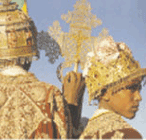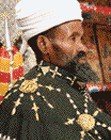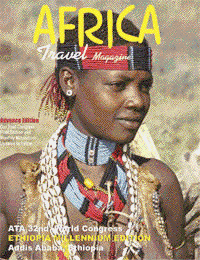|
|
|
|
|
|
|
|
|
|
As
our minibus rolled into Gondar, after a short
flight from Lalibela, there was ample evidence that
here was an area destined for long range
development as a destination resort. Several new
industries attest to this growing trend, as did our
conversation with entrepreneurs at the airport and
later at the hotel. Our modern, government operated
hotel, the Goha was perched like a sentinel on a
hilltop, with a commanding view of the city and
countryside.
Gondar
was Ethiopia's capital and principal city during
the reign of Emperor Fasilidas in the 17th century.
Perhaps that's why I expected to find it a shrine
to past glories, instead of an active, bustling
community, with people filling the streets, shops
doing a brisk business, and scores of gaudily
painted horse and buggy taxis (garis) scooting
every which way, like bumper cars at a
midway.
Several of
our group decided to try this hair raising means of
transport, and it became a highlight of their day,
trotting through the narrow alleys of this
centuries old
capital.
Thanks to a
massive government initiative, many of the castles,
palaces and royal structures built by the early
Emperors are being carefully restored. These
treasures of Gondar include the stone bathhouse of
Emperor Fasiladas and the ruined Palace of Kusquam.
We also entered the church of Debre Brhan Selassie,
to gaze in awe at its unique murals, which have
stood the test of time for centuries. These castles
display a richness in architecture that reveals the
influence of Arabia as well as Axumite traditions,
and are said to be the largest concentration of
such structures in Africa. (continued)
Bahir Dar, Lake Tana and the Blue Nile Falls.
 Gondar:
Africa's Camelot
Gondar:
Africa's Camelot











